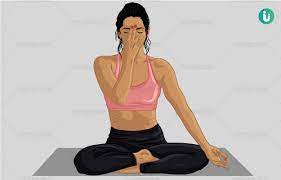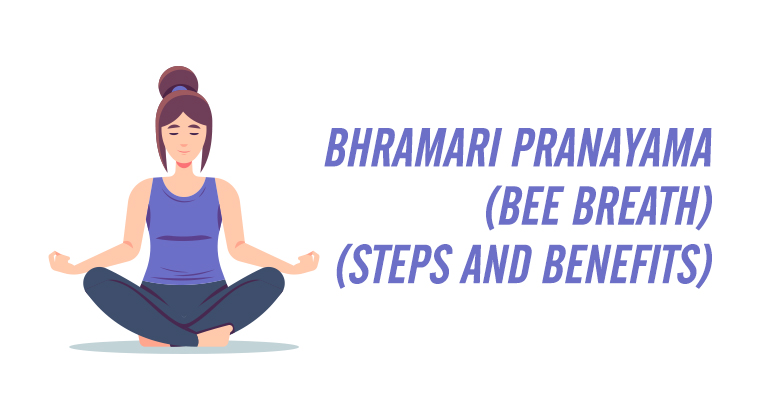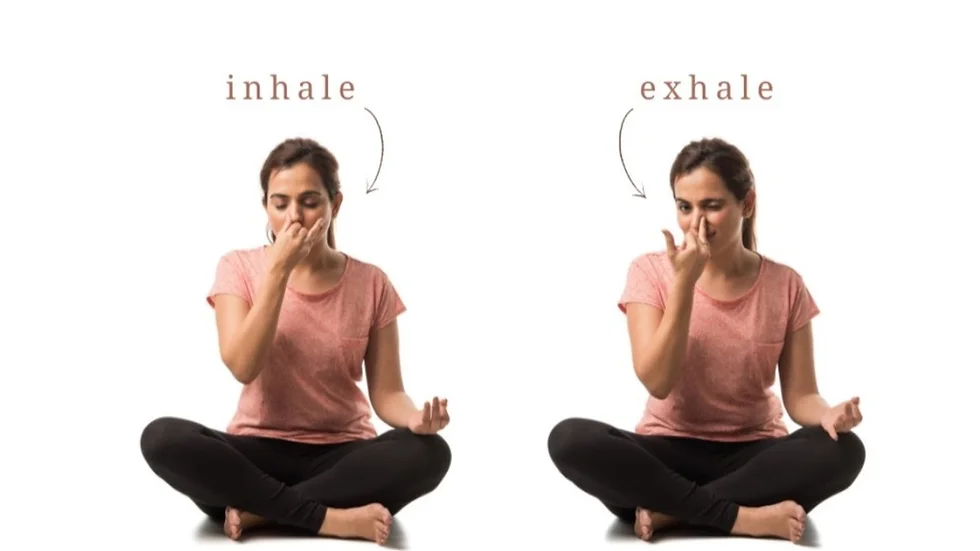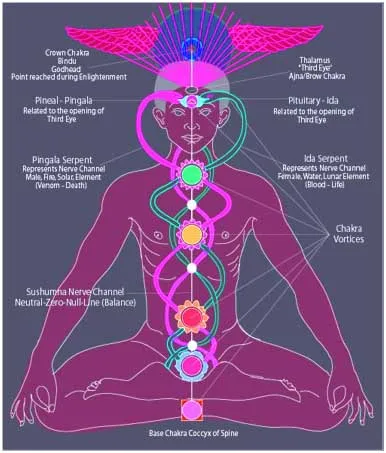What is Nadi Shodhana Pranayama (Alternate Nostril Breathing) - How to Pract-ce, Benefits and Precautions.
Pranayama is one of the many kriyas in yoga, which can help you to expand your breath and gain the power of energies. Breath and the energies are closely associated, with the help of nadis or channels. There are at least 72,000 nadis in the human body, through which energy of Prana travel. Any kind of blockages can lead to illness, of the physical as well as the mental kind. You can learn about Pranayama, from the Rishikesh Yoga School. Before, we move on to discuss about Nadi Shodhana Pranayama, you must know, how this breath circulates along with the energy or Prana. Along with that, you should also get some knowledge on the nadis in the astral body.

What Are The Nadis?
You will study about the nadis in complete detail in the 200 hour yoga teacher training in rishikesh, as well. So, we go back to the Vedic times or even before that period, to where life started from. Amazingly, every human is alive due to the energy flow through the body’s channels. It is also called Pranic energy. The energy flows through the Nadis. The Nadi channels are along the same pathways as the sympathetic nervous system. There are various energy channels in the human body that work in tandem with one another. If the nadis are healthy and unobstructed, the energy can flow freely through them. However, in case of any sort of blockage, you may suffer from physical, mental, as well as emotional issues.
Yoga practices like Hatha Yoga mainly talk about the sun and moon, and balancing of the two sides of the body. Moreover, there are asanas, kriyas, meditation, and breathing techniques that help with the clearing of the nadis or channels, thus facilitating the flow of energy. There are three main nadis, the Ida, Pingala and the Sushumna nadi, which are regarded as the most beneficial for humans. Ida represents the female side, Pingala the male side, and Sushumna the central one that passes through the spine. All three join forces at the Ajna chakra, and allows energy to pass to the Crown chakra and then merge with the universe.
The three most important nadis have already been mentioned above. However, the Vedic scripts say that there are 14 nadis in all. Let us find out more about each one.
Gandhari Nadi : The Gandhari Nadi originates from the Muladhara Chakra, which is at the base of the spine. It moves upwards and ends up at the Ajna chakra, or third eye chakra. This nadi activates the left eye.
Alambusha Nadi : The Alambusha nadi helps to bring energy to the organs and other parts of the body that excrete wastes. It travels from the interior of the body to the mouth.
Hasti Jeeva Nadi : This Hasti Jeeva nadi provides energy to the limbs. This nadi begins at the Muladhara chakra and ends at the Manipura Chakra, which is behind the navel.
Ida Nadi : This is an important nadi which begins at the Muladhara Chakra and ends at the left nostril. It acts on the left brain. This can promote the feelings of emotion and love, as it is governed by the lunar energy and also cools the brain.
Kuhu Nadi : This Nadi starts from the throat and ends at the genitals, and brings energy to this area.
Pusha Nadi : This nadi starts at the Muladhara Chakra, and ends at the third eye Chakra. Moreover, this Nadi provides energy to your right eye.
Saraswati Nadi : This Nadi rules over your mouth, tongue and throat. It begins at the Muladhara Chakra and ends at the Vishuddha Chakra, in the base of the throat.
Payaswini Nadi : The Payaswini Nadi begins from the right big toe, and flows up the body to end at the right ear.
Pingala Nadi : It is believed to promote perception and analysis, the Pingala Nadi is located on the right side of the body and ends at the right nostril. It is also called the male energy channel.
Sankhini Nadi : This Nadi activates the energy in your left ear, and begins at the Muladhara chakra and ends at the Ajna chakra.
Sushumna Nadi : This is the main Nadi, which starts at the Muladhara Chakra. Moreover, this Nadi ends at the crown of the head at the Sahasrara Chakra. Furthermore, this Nadi is the central Nadi that allows the flow of prana to the other Nadis around the body.
Varuna Nadi : This Nadi provides energy to the whole body, through the nerves. It starts from the Muladhara chakra and ends at the Anahata chakra.
Vishwadhara Nadi
This Nadi provides energy to the digestive system. Location wise, this Nadi begins at the Muladhara chakra and ends at the Manipura chakra.
Yashaswini Nadi : The Nadi provides energy to the right limbs and starts from the Muladhara chakra and ends at the Manipura chakra. You can also read about the same in a detailed manner in the yoga training in rishikesh.
Nadi Shodhana Pranayama
It is one of the most popular breathing techniques, which help in purification of the channels in the astral body. In this Pranayama, you have to breathe through alternate nostrils, one-by-one, and hence the name. When you have practiced this breathing technique a number of times, you will feel the nasal passages clearing. It is also a good starting breathing technique for all the other types of Pranayama. If you practice this Pranayama on a regular basis, you will find that your mind has become calm and still. When you practice the Nadi Shodhana Pranayama for some time, you can awaken the central and most important energy channel, which is called the Sushumna Nadi.
According to yogic studies, the energy inside the human body flows through certain channels. These will not be visible in any anatomy book. All the channels are present in the astral body. If, due to some physical and psychological factors, the channels get blocked, then the body may suffer from injuries, anxiety attacks, and negativity. The three important Nadis – Sushumna, Pingala and Ida are responsible for distributing the energies inside the entire body. You will be practicing this breathing technique as a part of Hatha Yoga practices.
You need to understand the working capacity of the Nadis in a better manner, so as to understand how it impacts the body. The Ida and Pingala Nadi run through both sides of the spine. When they are activated and clear, they activate the Sushumna Nadi, which runs through the spine. The Ida Nadi is representative of Tamas Guna. It is heavy, cool, and ruled by Moon. The Ida Nadi is accessible from the left nostril. On the other hand, Pingala Nadi is a representative of the sun, and it is a male energy. It is associated with the right nostril. When the Ida and Pingala Nadi are working at optimum levels, the Sushumna is activated and it clears the energy that flows through the seven chakras.
Preparation and Process Of Doing Nadi Shodhana
Before, you actually start with the process of Nadi Shodhana, you must perform certain preparatory actions. This applies to the beginners more.
The first action, that you need to take up, is the practice of Pranayama mudra. You can use the Vishnu mudra or the Nasagra mudra as well. Both mudras are made using the right hand. In the Vishnu mudra, you have to fold the index finger and the middle finger on the palm, whereas the thumb and the other two fingers remain stretched. You have to close the right nostril with the right thumb, and the left nostril with the ring finger. When you are retaining the breath, then you have to keep the thumb and the ring finger pressed on both nostrils.
You can learn about such breathing techniques in the 200 hour yoga TTC. Moreover, you can also do the Nasagra mudra, while practicing Nadi Shodhana. It is easier for all those, who find it a bit of a problem, to fold the fingers on the palm. In this practice, you must keep the index finger and middle finger in between the two eyebrows, which also activates the Ajna chakra. The other actions are almost similar, to the practice of Vishnu mudra.
You have to start with some simple breathing exercises, before you start with the Nadi Shodhana practice. You can also begin with single nostril breathing. Just follow the below mentioned steps, to do the Pranayama.
- You can sit in any meditative pose, like Padmasana, Sukhasana, or Siddhasana, to begin with. Close the right nostril with the right thumb, and inhale deeply through the left one. Exhale completely through the open nostril as well.
- Thereafter, you must close the left nostril. With the right ring finger, you have to close the nostril. Inhale and exhale in a similar manner, as you have done before.
- In this practice, you can start with a ratio of inhalation – exhalation of 1:1 or 1:2.
In the next stage of this practice, you must start with inhalation and exhalation with opposite nostrils at any given time.
- Sit in a meditative pose as before, and close the right nostril with the right thumb. Then, you have to take a deep breath with the left one. Then, close the left nostril with the right ring finger, and exhale out the air.
- You must do this for 10 cycles, wherein you inhale from the right and exhale from the left. It is also called Chandra Bhedana Pranayama.
- After 10thtime, you have to reverse the breathing. Inhale through the right one and exhale through the left one. This is equivalent to Surya Bhedana.
- When you combine both of these, it is called Nadi Shodhana.
The Actual Practice of Nadi Shodhana starts now.
- You have to start by sitting in any meditative pose as earlier.
- Make sure that the spine is erect. You can keep one hand on the knees.
- You can make the Vishnu mudra or Nasagra mudra with the right hand.
- Firstly, take a long deep breath with the left nostril, while keeping the right one closed. After inhalation, you need to close the left nostril with the ring finger of the right hand.
- You need to retain the breath in your body for a few seconds.
- Then you need to remove the thumb from the right nostril, and inhale the air. Hold the breath for some time, and then exhale out through the left. This will complete one round.
- You can do at least 20 rounds of the same.
Nadi Shodhana Pranayama Benefits
You should always practice slow and relaxed breathing, to start with. Do not press the nostrils to hard, as it may damage the tissues. Furthermore, an erect spine helps in proper contraction and expansion.
If you do the practice properly, you will get a number of benefits.
- It helps in synchronizing the function of both the hemispheres of the brain. Co-ordination will also improve manifold.
- It improves blood circulation through the entire body.
- It also helps in maintaining pulmonary health.
- Your Prana will be uplifted.
- It also helps in improving cardiovascular health.
- You can also activate the Sahasrara chakra, with proper practice.
These are just a few of the benefits, which you can avail yourself of. Do this regularly to start noticing the benefits. You can also choose Hrishikesh Yoga School for such practices.





